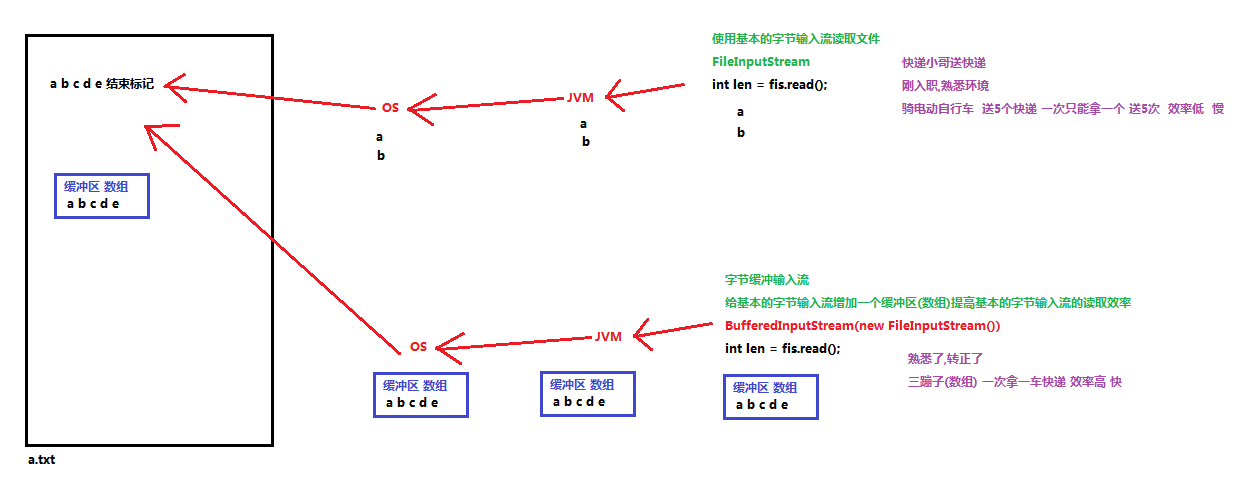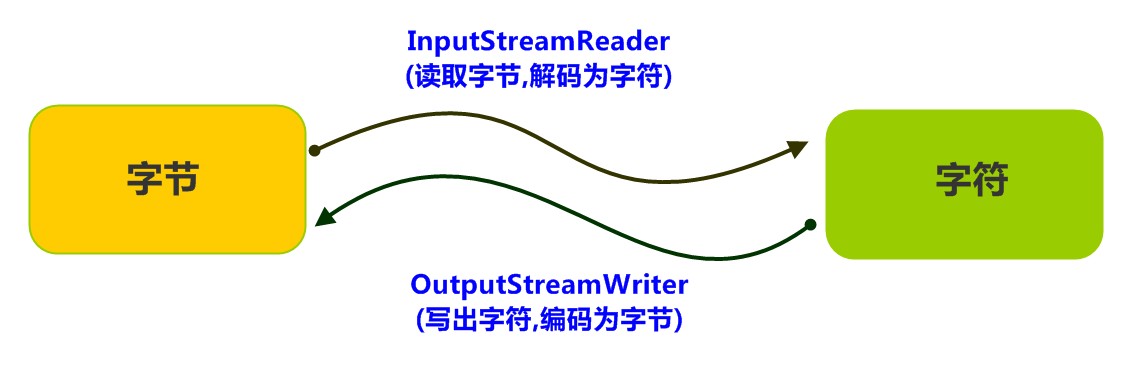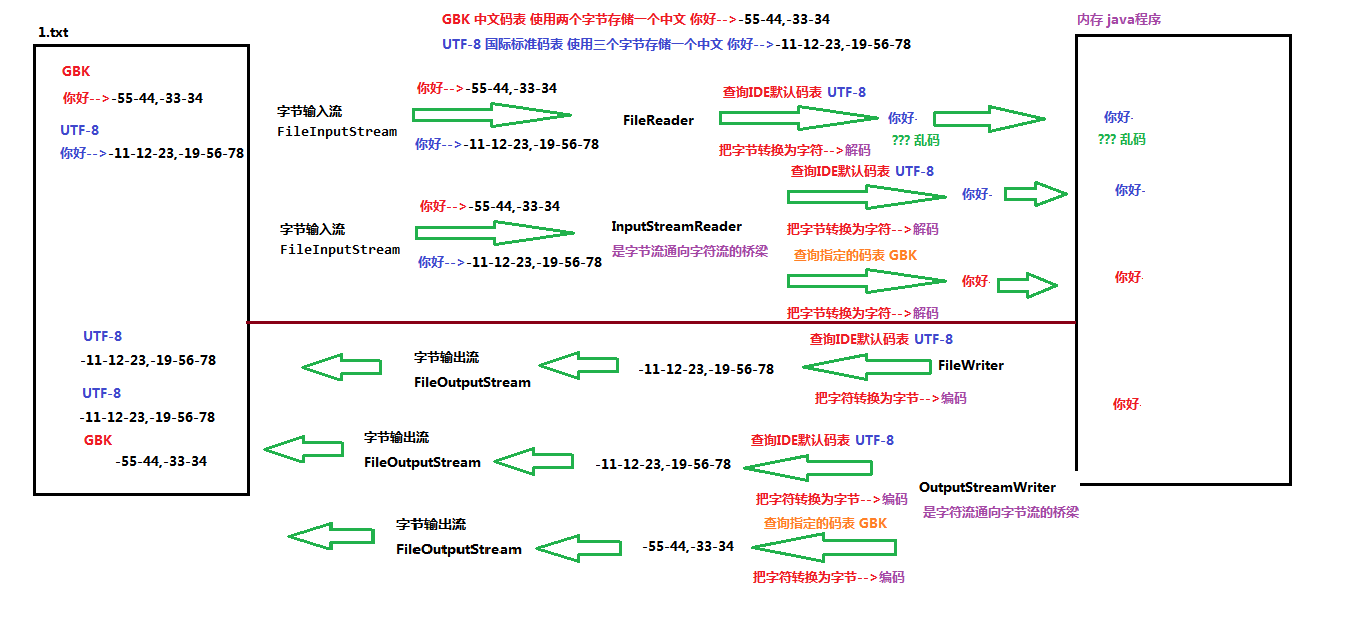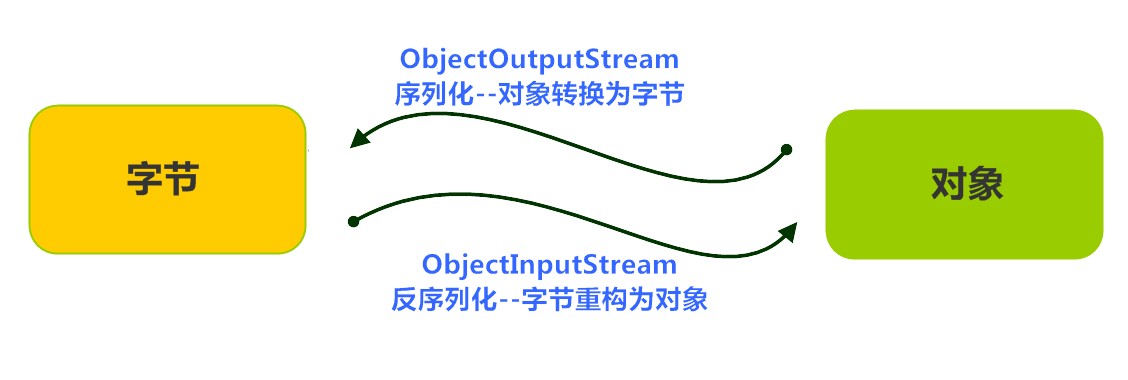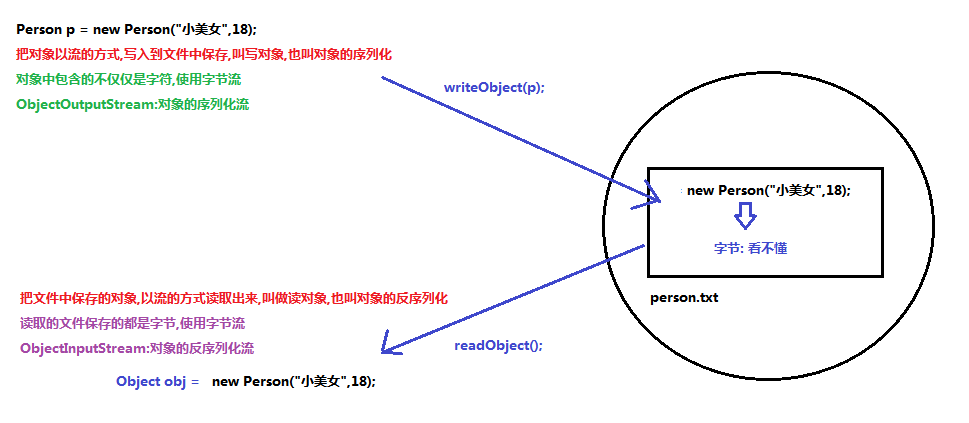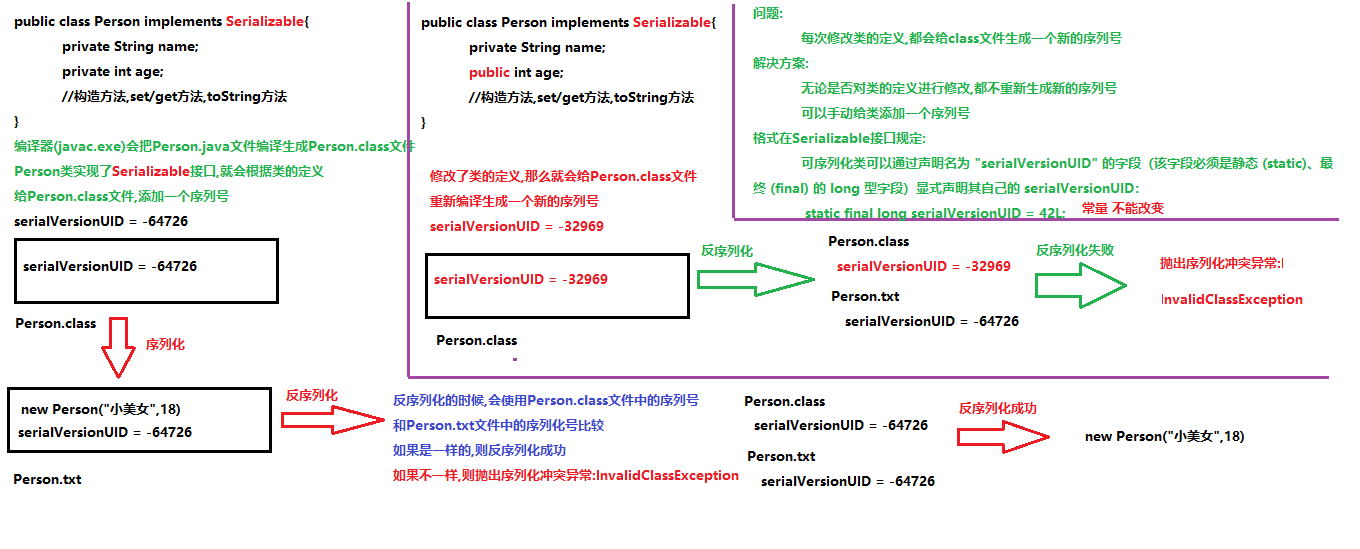缓冲流、转换流、序列化流 主要内容
教学目标
第一章 缓冲流 昨天学习了基本的一些流,作为IO流的入门,今天我们要见识一些更强大的流。比如能够高效读写的缓冲流,能够转换编码的转换流,能够持久化存储对象的序列化流等等。这些功能更为强大的流,都是在基本的流对象基础之上创建而来的,就像穿上铠甲的武士一样,相当于是对基本流对象的一种增强。
1.1 概述 缓冲流,也叫高效流 ,是对4个基本的FileXxx 流的增强,所以也是4个流,按照数据类型分类:
字节缓冲流 :BufferedInputStream,BufferedOutputStream 字符缓冲流 :BufferedReader,BufferedWriter
缓冲流的基本原理,是在创建流对象时,会创建一个内置的默认大小的缓冲区数组,通过缓冲区读写,减少系统IO次数,从而提高读写的效率。
1.2 字节缓冲流 构造方法
public BufferedInputStream(InputStream in) :创建一个 新的缓冲输入流。 public BufferedOutputStream(OutputStream out): 创建一个新的缓冲输出流。
构造举例,代码如下:
1 2 3 4 BufferedInputStream bis = new BufferedInputStream(new FileInputStream("bis.txt" )); BufferedOutputStream bos = new BufferedOutputStream(new FileOutputStream("bos.txt" ));
BufferedInputStream
1 2 3 4 5 6 7 8 9 10 11 12 13 14 15 16 17 18 19 20 21 22 23 24 25 26 27 28 29 30 31 32 33 34 35 36 37 38 39 40 41 42 43 44 45 46 47 48 49 50 51 52 53 package com.itheima.demo01.BufferedStream;import java.io.BufferedInputStream;import java.io.FileInputStream;import java.io.IOException;public class Demo02BufferedInputStream public static void main (String[] args) throws IOException FileInputStream fis = new FileInputStream("10_IO\\a.txt" ); BufferedInputStream bis = new BufferedInputStream(fis); byte [] bytes =new byte [1024 ]; int len = 0 ; while ((len = bis.read(bytes))!=-1 ){ System.out.println(new String(bytes,0 ,len)); } bis.close(); } }
BufferedOutputStream
1 2 3 4 5 6 7 8 9 10 11 12 13 14 15 16 17 18 19 20 21 22 23 24 25 26 27 28 29 30 31 32 33 34 35 36 37 38 39 40 41 42 43 44 45 46 package com.itheima.demo01.BufferedStream;import java.io.BufferedOutputStream;import java.io.FileOutputStream;import java.io.IOException;public class Demo01BufferedOutputStream public static void main (String[] args) throws IOException FileOutputStream fos = new FileOutputStream("10_IO\\a.txt" ); BufferedOutputStream bos = new BufferedOutputStream(fos); bos.write("我把数据写入到内部缓冲区中" .getBytes()); bos.flush(); bos.close(); } }
效率测试 查询API,缓冲流读写方法与基本的流是一致的,我们通过复制大文件(375MB),测试它的效率。
基本流,代码如下:
1 2 3 4 5 6 7 8 9 10 11 12 13 14 15 16 17 18 19 20 21 22 23 24 public class BufferedDemo public static void main (String[] args) throws FileNotFoundException long start = System.currentTimeMillis(); try ( FileInputStream fis = new FileInputStream("jdk9.exe" ); FileOutputStream fos = new FileOutputStream("copy.exe" ) ){ int b; while ((b = fis.read()) != -1 ) { fos.write(b); } } catch (IOException e) { e.printStackTrace(); } long end = System.currentTimeMillis(); System.out.println("普通流复制时间:" +(end - start)+" 毫秒" ); } } 十几分钟过去了...
缓冲流,代码如下:
1 2 3 4 5 6 7 8 9 10 11 12 13 14 15 16 17 18 19 20 21 22 23 24 public class BufferedDemo public static void main (String[] args) throws FileNotFoundException long start = System.currentTimeMillis(); try ( BufferedInputStream bis = new BufferedInputStream(new FileInputStream("jdk9.exe" )); BufferedOutputStream bos = new BufferedOutputStream(new FileOutputStream("copy.exe" )); ){ int b; while ((b = bis.read()) != -1 ) { bos.write(b); } } catch (IOException e) { e.printStackTrace(); } long end = System.currentTimeMillis(); System.out.println("缓冲流复制时间:" +(end - start)+" 毫秒" ); } } 缓冲流复制时间:8016 毫秒
如何更快呢?
使用数组的方式,代码如下:
1 2 3 4 5 6 7 8 9 10 11 12 13 14 15 16 17 18 19 20 21 22 23 24 public class BufferedDemo public static void main (String[] args) throws FileNotFoundException long start = System.currentTimeMillis(); try ( BufferedInputStream bis = new BufferedInputStream(new FileInputStream("jdk9.exe" )); BufferedOutputStream bos = new BufferedOutputStream(new FileOutputStream("copy.exe" )); ){ int len; byte [] bytes = new byte [8 *1024 ]; while ((len = bis.read(bytes)) != -1 ) { bos.write(bytes, 0 , len); } } catch (IOException e) { e.printStackTrace(); } long end = System.currentTimeMillis(); System.out.println("缓冲流使用数组复制时间:" +(end - start)+" 毫秒" ); } } 缓冲流使用数组复制时间:666 毫秒
demo in class
1 2 3 4 5 6 7 8 9 10 11 12 13 14 15 16 17 18 19 20 21 22 23 24 25 26 27 28 29 30 31 32 33 34 35 36 37 38 39 40 41 42 43 44 45 46 47 48 49 50 51 52 53 54 55 package com.itheima.demo02.CopyFile;import java.io.FileInputStream;import java.io.FileOutputStream;import java.io.IOException;public class Demo01CopyFile public static void main (String[] args) throws IOException long s = System.currentTimeMillis(); FileInputStream fis = new FileInputStream("c:\\1.jpg" ); FileOutputStream fos = new FileOutputStream("d:\\1.jpg" ); byte [] bytes = new byte [1024 ]; int len = 0 ; while ((len = fis.read(bytes))!=-1 ){ fos.write(bytes,0 ,len); } fos.close(); fis.close(); long e = System.currentTimeMillis(); System.out.println("复制文件共耗时:" +(e-s)+"毫秒" ); } }
1.3 字符缓冲流 构造方法
public BufferedReader(Reader in) :创建一个 新的缓冲输入流。 public BufferedWriter(Writer out): 创建一个新的缓冲输出流。
构造举例,代码如下:
1 2 3 4 BufferedReader br = new BufferedReader(new FileReader("br.txt" )); BufferedWriter bw = new BufferedWriter(new FileWriter("bw.txt" ));
特有方法 字符缓冲流的基本方法与普通字符流调用方式一致,不再阐述,我们来看它们具备的特有方法。
BufferedReader:public String readLine(): 读一行文字。
BufferedWriter:public void newLine(): 写一行行分隔符,由系统属性定义符号。
readLine方法演示,代码如下:
1 2 3 4 5 6 7 8 9 10 11 12 13 14 15 public class BufferedReaderDemo public static void main (String[] args) throws IOException BufferedReader br = new BufferedReader(new FileReader("in.txt" )); String line = null ; while ((line = br.readLine())!=null ) { System.out.print(line); System.out.println("------" ); } br.close(); } }
newLine方法演示,代码如下:
1 2 3 4 5 6 7 8 9 10 11 12 13 14 15 16 17 18 19 20 public class BufferedWriterDemo throws IOException public static void main (String[] args) throws IOException BufferedWriter bw = new BufferedWriter(new FileWriter("out.txt" )); bw.write("黑马" ); bw.newLine(); bw.write("程序" ); bw.newLine(); bw.write("员" ); bw.newLine(); bw.close(); } } 输出效果: 黑马 程序 员
BufferedWriter&newline()
1 2 3 4 5 6 7 8 9 10 11 12 13 14 15 16 17 18 19 20 21 22 23 24 25 26 27 28 29 30 31 32 33 34 35 36 37 38 39 40 41 42 43 44 45 46 47 48 49 50 51 52 53 54 55 56 package com.itheima.demo01.BufferedStream;import java.io.BufferedWriter;import java.io.FileWriter;import java.io.IOException;public class Demo03BufferedWriter public static void main (String[] args) throws IOException BufferedWriter bw = new BufferedWriter(new FileWriter("10_IO\\c.txt" )); for (int i = 0 ; i <10 ; i++) { bw.write("传智播客" ); bw.newLine(); } bw.flush(); bw.close(); } }
BufferedReader
1 2 3 4 5 6 7 8 9 10 11 12 13 14 15 16 17 18 19 20 21 22 23 24 25 26 27 28 29 30 31 32 33 34 35 36 37 38 39 40 41 42 43 44 45 46 47 48 49 50 51 52 53 54 55 56 57 58 59 60 61 62 63 64 package com.itheima.demo01.BufferedStream;import java.io.BufferedReader;import java.io.FileReader;import java.io.IOException;public class Demo04BufferedReader public static void main (String[] args) throws IOException BufferedReader br = new BufferedReader(new FileReader("10_IO\\c.txt" )); String line; while ((line = br.readLine())!=null ){ System.out.println(line); } br.close(); } }
1.4 练习:文本排序 请将文本信息恢复顺序。
1 2 3 4 5 6 7 8 9 3.侍中、侍郎郭攸之、费祎、董允等,此皆良实,志虑忠纯,是以先帝简拔以遗陛下。愚以为宫中之事,事无大小,悉以咨之,然后施行,必得裨补阙漏,有所广益。 8.愿陛下托臣以讨贼兴复之效,不效,则治臣之罪,以告先帝之灵。若无兴德之言,则责攸之、祎、允等之慢,以彰其咎;陛下亦宜自谋,以咨诹善道,察纳雅言,深追先帝遗诏,臣不胜受恩感激。 4.将军向宠,性行淑均,晓畅军事,试用之于昔日,先帝称之曰能,是以众议举宠为督。愚以为营中之事,悉以咨之,必能使行阵和睦,优劣得所。 2.宫中府中,俱为一体,陟罚臧否,不宜异同。若有作奸犯科及为忠善者,宜付有司论其刑赏,以昭陛下平明之理,不宜偏私,使内外异法也。 1.先帝创业未半而中道崩殂,今天下三分,益州疲弊,此诚危急存亡之秋也。然侍卫之臣不懈于内,忠志之士忘身于外者,盖追先帝之殊遇,欲报之于陛下也。诚宜开张圣听,以光先帝遗德,恢弘志士之气,不宜妄自菲薄,引喻失义,以塞忠谏之路也。 9.今当远离,临表涕零,不知所言。 6.臣本布衣,躬耕于南阳,苟全性命于乱世,不求闻达于诸侯。先帝不以臣卑鄙,猥自枉屈,三顾臣于草庐之中,咨臣以当世之事,由是感激,遂许先帝以驱驰。后值倾覆,受任于败军之际,奉命于危难之间,尔来二十有一年矣。 7.先帝知臣谨慎,故临崩寄臣以大事也。受命以来,夙夜忧叹,恐付托不效,以伤先帝之明,故五月渡泸,深入不毛。今南方已定,兵甲已足,当奖率三军,北定中原,庶竭驽钝,攘除奸凶,兴复汉室,还于旧都。此臣所以报先帝而忠陛下之职分也。至于斟酌损益,进尽忠言,则攸之、祎、允之任也。 5.亲贤臣,远小人,此先汉所以兴隆也;亲小人,远贤臣,此后汉所以倾颓也。先帝在时,每与臣论此事,未尝不叹息痛恨于桓、灵也。侍中、尚书、长史、参军,此悉贞良死节之臣,愿陛下亲之信之,则汉室之隆,可计日而待也。
案例分析
逐行读取文本信息。
解析文本信息到集合中。
遍历集合,按顺序,写出文本信息。
案例实现 1 2 3 4 5 6 7 8 9 10 11 12 13 14 15 16 17 18 19 20 21 22 23 24 25 26 27 28 29 30 31 32 33 34 public class BufferedTest public static void main (String[] args) throws IOException HashMap<String, String> lineMap = new HashMap<>(); BufferedReader br = new BufferedReader(new FileReader("in.txt" )); BufferedWriter bw = new BufferedWriter(new FileWriter("out.txt" )); String line = null ; while ((line = br.readLine())!=null ) { String[] split = line.split("\\." ); lineMap.put(split[0 ],split[1 ]); } br.close(); for (int i = 1 ; i <= lineMap.size(); i++) { String key = String.valueOf(i); String value = lineMap.get(key); bw.write(key+"." +value); bw.newLine(); } bw.close(); } }
demo detailed explanation
1 2 3 4 5 6 7 8 9 10 11 12 13 14 15 16 17 18 19 20 21 22 23 24 25 26 27 28 29 30 31 32 33 34 35 36 37 38 39 40 41 42 43 44 45 46 47 48 49 50 51 52 package com.itheima.demo01.BufferedStream;import java.io.*;import java.util.HashMap;public class Demo05Test public static void main (String[] args) throws IOException HashMap<String,String> map = new HashMap<>(); BufferedReader br = new BufferedReader(new FileReader("10_IO\\in.txt" )); BufferedWriter bw = new BufferedWriter(new FileWriter("10_IO\\out.txt" )); String line; while ((line = br.readLine())!=null ){ String[] arr = line.split("\\." ); map.put(arr[0 ],arr[1 ]); } for (String key : map.keySet()){ String value = map.get(key); line = key + "." + value; bw.write(line); bw.newLine(); } bw.close(); br.close(); } }
第二章 转换流 2.1 字符编码和字符集 字符编码 计算机中储存的信息都是用二进制数表示的,而我们在屏幕上看到的数字、英文、标点符号、汉字等字符是二进制数转换之后的结果。按照某种规则,将字符存储到计算机中,称为编码 。反之,将存储在计算机中的二进制数按照某种规则解析显示出来,称为解码 。比如说,按照A规则存储,同样按照A规则解析,那么就能显示正确的文本符号。反之,按照A规则存储,再按照B规则解析,就会导致乱码现象。
编码:字符(能看懂的)–字节(看不懂的)
解码:字节(看不懂的)–>字符(能看懂的)
字符集
**字符集 Charset**:也叫编码表。是一个系统支持的所有字符的集合,包括各国家文字、标点符号、图形符号、数字等。
计算机要准确的存储和识别各种字符集符号,需要进行字符编码,一套字符集必然至少有一套字符编码。常见字符集有ASCII字符集、GBK字符集、Unicode字符集等。
可见,当指定了编码 ,它所对应的字符集 自然就指定了,所以编码 才是我们最终要关心的。
ASCII字符集 :
ASCII(American Standard Code for Information Interchange,美国信息交换标准代码)是基于拉丁字母的一套电脑编码系统,用于显示现代英语,主要包括控制字符(回车键、退格、换行键等)和可显示字符(英文大小写字符、阿拉伯数字和西文符号)。
基本的ASCII字符集,使用7位(bits)表示一个字符,共128字符。ASCII的扩展字符集使用8位(bits)表示一个字符,共256字符,方便支持欧洲常用字符。
ISO-8859-1字符集 :
拉丁码表,别名Latin-1,用于显示欧洲使用的语言,包括荷兰、丹麦、德语、意大利语、西班牙语等。
ISO-8859-1使用单字节编码,兼容ASCII编码。
GBxxx字符集 :
GB就是国标的意思,是为了显示中文而设计的一套字符集。
GB2312 :简体中文码表。一个小于127的字符的意义与原来相同。但两个大于127的字符连在一起时,就表示一个汉字,这样大约可以组合了包含7000多个简体汉字,此外数学符号、罗马希腊的字母、日文的假名们都编进去了,连在ASCII里本来就有的数字、标点、字母都统统重新编了两个字节长的编码,这就是常说的”全角”字符,而原来在127号以下的那些就叫”半角”字符了。GBK :最常用的中文码表。是在GB2312标准基础上的扩展规范,使用了双字节编码方案,共收录了21003个汉字,完全兼容GB2312标准,同时支持繁体汉字以及日韩汉字等。GB18030 :最新的中文码表。收录汉字70244个,采用多字节编码,每个字可以由1个、2个或4个字节组成。支持中国国内少数民族的文字,同时支持繁体汉字以及日韩汉字等。
Unicode字符集 :
Unicode编码系统为表达任意语言的任意字符而设计,是业界的一种标准,也称为统一码、标准万国码。
它最多使用4个字节的数字来表达每个字母、符号,或者文字。有三种编码方案,UTF-8、UTF-16和UTF-32。最为常用的UTF-8编码。
UTF-8编码,可以用来表示Unicode标准中任何字符,它是电子邮件、网页及其他存储或传送文字的应用中,优先采用的编码。互联网工程工作小组(IETF)要求所有互联网协议都必须支持UTF-8编码。所以,我们开发Web应用,也要使用UTF-8编码。它使用一至四个字节为每个字符编码,编码规则:
128个US-ASCII字符,只需一个字节编码。
拉丁文等字符,需要二个字节编码。
大部分常用字(含中文),使用三个字节编码。
其他极少使用的Unicode辅助字符,使用四字节编码。
2.2 编码引出的问题 在IDEA中,使用FileReader 读取项目中的文本文件。由于IDEA的设置,都是默认的UTF-8编码,所以没有任何问题。但是,当读取Windows系统中创建的文本文件时,由于Windows系统的默认是GBK编码,就会出现乱码。
1 2 3 4 5 6 7 8 9 10 11 12 public class ReaderDemo public static void main (String[] args) throws IOException FileReader fileReader = new FileReader("E:\\File_GBK.txt" ); int read; while ((read = fileReader.read()) != -1 ) { System.out.print((char )read); } fileReader.close(); } } 输出结果: ���
那么如何读取GBK编码的文件呢?
转换流java.io.InputStreamReader,是Reader的子类,是从字节流到字符流的桥梁。它读取字节,并使用指定的字符集将其解码为字符。它的字符集可以由名称指定,也可以接受平台的默认字符集。
构造方法
InputStreamReader(InputStream in): 创建一个使用默认字符集的字符流。 InputStreamReader(InputStream in, String charsetName): 创建一个指定字符集的字符流。
构造举例,代码如下:
1 2 InputStreamReader isr = new InputStreamReader(new FileInputStream("in.txt" )); InputStreamReader isr2 = new InputStreamReader(new FileInputStream("in.txt" ) , "GBK" );
指定编码读取 1 2 3 4 5 6 7 8 9 10 11 12 13 14 15 16 17 18 19 20 21 22 23 public class ReaderDemo2 public static void main (String[] args) throws IOException String FileName = "E:\\file_gbk.txt" ; InputStreamReader isr = new InputStreamReader(new FileInputStream(FileName)); InputStreamReader isr2 = new InputStreamReader(new FileInputStream(FileName) , "GBK" ); int read; while ((read = isr.read()) != -1 ) { System.out.print((char )read); } isr.close(); while ((read = isr2.read()) != -1 ) { System.out.print((char )read); } isr2.close(); } }
2.4 OutputStreamWriter类 转换流java.io.OutputStreamWriter ,是Writer的子类,是从字符流到字节流的桥梁。使用指定的字符集将字符编码为字节。它的字符集可以由名称指定,也可以接受平台的默认字符集。
构造方法
OutputStreamWriter(OutputStream in): 创建一个使用默认字符集的字符流。 OutputStreamWriter(OutputStream in, String charsetName): 创建一个指定字符集的字符流。
构造举例,代码如下:
1 2 OutputStreamWriter isr = new OutputStreamWriter(new FileOutputStream("out.txt" )); OutputStreamWriter isr2 = new OutputStreamWriter(new FileOutputStream("out.txt" ) , "GBK" );
指定编码写出 1 2 3 4 5 6 7 8 9 10 11 12 13 14 15 16 17 18 19 public class OutputDemo public static void main (String[] args) throws IOException String FileName = "E:\\out.txt" ; OutputStreamWriter osw = new OutputStreamWriter(new FileOutputStream(FileName)); osw.write("你好" ); osw.close(); String FileName2 = "E:\\out2.txt" ; OutputStreamWriter osw2 = new OutputStreamWriter(new FileOutputStream(FileName2),"GBK" ); osw2.write("你好" ); osw2.close(); } }
转换流理解图解 转换流是字节与字符间的桥梁 !
2.5 练习:转换文件编码 将GBK编码的文本文件,转换为UTF-8编码的文本文件。
案例分析
指定GBK编码的转换流,读取文本文件。
使用UTF-8编码的转换流,写出文本文件。
案例实现 1 2 3 4 5 6 7 8 9 10 11 12 13 14 15 16 17 18 19 20 21 22 23 24 25 public class TransDemo public static void main (String[] args) String srcFile = "file_gbk.txt" ; String destFile = "file_utf8.txt" ; InputStreamReader isr = new InputStreamReader(new FileInputStream(srcFile) , "GBK" ); OutputStreamWriter osw = new OutputStreamWriter(new FileOutputStream(destFile)); char [] cbuf = new char [1024 ]; int len; while ((len = isr.read(cbuf))!=-1 ) { osw.write(cbuf,0 ,len); } osw.close(); isr.close(); } }
demo in class
1 2 3 4 5 6 7 8 9 10 11 12 13 14 15 16 17 18 19 20 21 22 23 24 25 26 27 28 29 30 31 32 package com.itheima.demo03.ReverseStream;import java.io.*;public class Demo04Test public static void main (String[] args) throws IOException InputStreamReader isr = new InputStreamReader(new FileInputStream("10_IO\\我是GBK格式的文本.txt" ),"GBK" ); OutputStreamWriter osw = new OutputStreamWriter(new FileOutputStream("10_IO\\我是utf_8格式的文件.txt" ),"UTF-8" ); int len = 0 ; while ((len = isr.read())!=-1 ){ osw.write(len); } osw.close(); isr.close(); } }
OutputStreamWriter
1 2 3 4 5 6 7 8 9 10 11 12 13 14 15 16 17 18 19 20 21 22 23 24 25 26 27 28 29 30 31 32 33 34 35 36 37 38 39 40 41 42 43 44 45 46 47 48 49 50 51 52 53 54 55 56 57 58 59 60 61 62 63 64 65 package com.itheima.demo03.ReverseStream;import java.io.FileOutputStream;import java.io.IOException;import java.io.OutputStreamWriter;public class Demo02OutputStreamWriter public static void main (String[] args) throws IOException write_gbk(); } private static void write_gbk () throws IOException OutputStreamWriter osw = new OutputStreamWriter(new FileOutputStream("10_IO\\gbk.txt" ),"GBK" ); osw.write("你好" ); osw.flush(); osw.close(); } private static void write_utf_8 () throws IOException OutputStreamWriter osw = new OutputStreamWriter(new FileOutputStream("10_IO\\utf_8.txt" )); osw.write("你好" ); osw.flush(); osw.close(); } }
InputStreamReader
1 2 3 4 5 6 7 8 9 10 11 12 13 14 15 16 17 18 19 20 21 22 23 24 25 26 27 28 29 30 31 32 33 34 35 36 37 38 39 40 41 42 43 44 45 46 47 48 49 50 51 52 53 54 55 56 57 58 59 60 61 62 63 64 65 66 67 package com.itheima.demo03.ReverseStream;import java.io.FileInputStream;import java.io.IOException;import java.io.InputStreamReader;public class Demo03InputStreamReader public static void main (String[] args) throws IOException read_gbk(); } private static void read_gbk () throws IOException InputStreamReader isr = new InputStreamReader(new FileInputStream("10_IO\\gbk.txt" ),"GBK" ); int len = 0 ; while ((len = isr.read())!=-1 ){ System.out.println((char )len); } isr.close(); } private static void read_utf_8 () throws IOException InputStreamReader isr = new InputStreamReader(new FileInputStream("10_IO\\utf_8.txt" )); int len = 0 ; while ((len = isr.read())!=-1 ){ System.out.println((char )len); } isr.close(); } }
第三章 序列化 3.1 概述 Java 提供了一种对象序列化 的机制。用一个字节序列可以表示一个对象,该字节序列包含该对象的数据、对象的类型和对象中存储的属性等信息。字节序列写出到文件之后,相当于文件中持久保存 了一个对象的信息。
反之,该字节序列还可以从文件中读取回来,重构对象,对它进行反序列化 。对象的数据、对象的类型和对象中存储的数据信息,都可以用来在内存中创建对象。看图理解序列化:
3.2 ObjectOutputStream类 java.io.ObjectOutputStream 类,将Java对象的原始数据类型写出到文件,实现对象的持久存储。
构造方法
public ObjectOutputStream(OutputStream out) : 创建一个指定OutputStream的ObjectOutputStream。
构造举例,代码如下:
1 2 FileOutputStream fileOut = new FileOutputStream("employee.txt" ); ObjectOutputStream out = new ObjectOutputStream(fileOut);
序列化操作
一个对象要想序列化,必须满足两个条件:
该类必须实现java.io.Serializable 接口,Serializable 是一个标记接口,不实现此接口的类将不会使任何状态序列化或反序列化,会抛出NotSerializableException 。
该类的所有属性必须是可序列化的。如果有一个属性不需要可序列化的,则该属性必须注明是瞬态的,使用transient 关键字修饰。
static关键字:静态关键字
静态优先于非静态加载到内存中(静态优先于对象进入到内存中)
被static修饰的成员变量不能被序列化的,序列化的都是对象
private static int age;
oos.writeObject(new Person("小美女",18));
Object o = ois.readObject();
Person{name='小美女', age=0} transient关键字:瞬态关键字
被transient修饰成员变量,不能被序列化
private transient int age;
oos.writeObject(new Person("小美女",18));
Object o = ois.readObject();
Person{name='小美女', age=0}1 2 3 4 5 6 7 8 public class Employee implements java .io .Serializable public String name; public String address; public transient int age; public void addressCheck () System.out.println("Address check : " + name + " -- " + address); } }
2.写出对象方法
public final void writeObject (Object obj) : 将指定的对象写出。
1 2 3 4 5 6 7 8 9 10 11 12 13 14 15 16 17 18 19 20 21 22 public class SerializeDemo public static void main (String [] args) Employee e = new Employee(); e.name = "zhangsan" ; e.address = "beiqinglu" ; e.age = 20 ; try { ObjectOutputStream out = new ObjectOutputStream(new FileOutputStream("employee.txt" )); out.writeObject(e); out.close(); fileOut.close(); System.out.println("Serialized data is saved" ); } catch (IOException i) { i.printStackTrace(); } } } 输出结果: Serialized data is saved
ObjectOutputStream
1 2 3 4 5 6 7 8 9 10 11 12 13 14 15 16 17 18 19 20 21 22 23 24 25 26 27 28 29 30 31 32 33 package com.itheima.demo04.ObjectStream;import java.io.FileOutputStream;import java.io.IOException;import java.io.ObjectOutputStream;public class Demo01ObjectOutputStream public static void main (String[] args) throws IOException ObjectOutputStream oos = new ObjectOutputStream(new FileOutputStream("10_IO\\person.txt" )); oos.writeObject(new Person("小美女" ,18 )); oos.close(); } }
Person
1 2 3 4 5 6 7 8 9 10 11 12 13 14 15 16 17 18 19 20 21 22 23 24 25 26 27 28 29 30 31 32 33 34 35 36 37 38 39 40 41 42 43 44 45 46 47 48 49 50 51 52 53 54 55 56 57 58 59 60 61 62 63 64 65 66 67 68 69 70 package com.itheima.demo04.ObjectStream;import java.io.Serializable;public class Person implements Serializable private static final long serialVersionUID = 1L ; private String name; public int age; public Person () } public Person (String name, int age) this .name = name; this .age = age; } @Override public String toString () return "Person{" + "name='" + name + '\'' + ", age=" + age + '}' ; } public String getName () return name; } public void setName (String name) this .name = name; } public int getAge () return age; } public void setAge (int age) this .age = age; } }
ObjectInputStream反序列化流,将之前使用ObjectOutputStream序列化的原始数据恢复为对象。
构造方法
public ObjectInputStream(InputStream in) : 创建一个指定InputStream的ObjectInputStream。
反序列化操作1 如果能找到一个对象的class文件,我们可以进行反序列化操作,调用ObjectInputStream读取对象的方法:
public final Object readObject () : 读取一个对象。
1 2 3 4 5 6 7 8 9 10 11 12 13 14 15 16 17 18 19 20 21 22 23 24 25 26 27 28 public class DeserializeDemo public static void main (String [] args) Employee e = null ; try { FileInputStream fileIn = new FileInputStream("employee.txt" ); ObjectInputStream in = new ObjectInputStream(fileIn); e = (Employee) in.readObject(); in.close(); fileIn.close(); }catch (IOException i) { i.printStackTrace(); return ; }catch (ClassNotFoundException c) { System.out.println("Employee class not found" ); c.printStackTrace(); return ; } System.out.println("Name: " + e.name); System.out.println("Address: " + e.address); System.out.println("age: " + e.age); } }
对于JVM可以反序列化对象,它必须是能够找到class文件的类。如果找不到该类的class文件,则抛出一个 ClassNotFoundException 异常。
反序列化操作2 另外,当JVM反序列化对象时,能找到class文件,但是class文件在序列化对象之后发生了修改,那么反序列化操作也会失败,抛出一个InvalidClassException异常。 发生这个异常的原因如下:
该类的序列版本号与从流中读取的类描述符的版本号不匹配
该类包含未知数据类型
该类没有可访问的无参数构造方法
Serializable 接口给需要序列化的类,提供了一个序列版本号。serialVersionUID 该版本号的目的在于验证序列化的对象和对应类是否版本匹配。
1 2 3 4 5 6 7 8 9 10 11 12 public class Employee implements java .io .Serializable private static final long serialVersionUID = 1L ; public String name; public String address; public int eid; public void addressCheck () System.out.println("Address check : " + name + " -- " + address); } }
demo in ObjectInputStream
1 2 3 4 5 6 7 8 9 10 11 12 13 14 15 16 17 18 19 20 21 22 23 24 25 26 27 28 29 30 31 32 33 34 35 36 37 38 39 40 41 42 43 44 45 package com.itheima.demo04.ObjectStream;import java.io.FileInputStream;import java.io.IOException;import java.io.ObjectInputStream;public class Demo02ObjectInputStream public static void main (String[] args) throws IOException, ClassNotFoundException ObjectInputStream ois = new ObjectInputStream(new FileInputStream("10_IO\\person.txt" )); Object o = ois.readObject(); ois.close(); System.out.println(o); Person p = (Person)o; System.out.println(p.getName()+p.getAge()); } }
3.4 练习:序列化集合
将存有多个自定义对象的集合序列化操作,保存到list.txt文件中。
反序列化list.txt ,并遍历集合,打印对象信息。
案例分析
把若干学生对象 ,保存到集合中。
把集合序列化。
反序列化读取时,只需要读取一次,转换为集合类型。
遍历集合,可以打印所有的学生信息
案例实现 1 2 3 4 5 6 7 8 9 10 11 12 13 14 15 16 17 18 19 20 21 22 23 24 25 26 27 28 29 30 31 32 33 34 public class SerTest public static void main (String[] args) throws Exception Student student = new Student("老王" , "laow" ); Student student2 = new Student("老张" , "laoz" ); Student student3 = new Student("老李" , "laol" ); ArrayList<Student> arrayList = new ArrayList<>(); arrayList.add(student); arrayList.add(student2); arrayList.add(student3); ObjectInputStream ois = new ObjectInputStream(new FileInputStream("list.txt" )); ArrayList<Student> list = (ArrayList<Student>)ois.readObject(); for (int i = 0 ; i < list.size(); i++ ){ Student s = list.get(i); System.out.println(s.getName()+"--" + s.getPwd()); } } private static void serializ (ArrayList<Student> arrayList) throws Exception ObjectOutputStream oos = new ObjectOutputStream(new FileOutputStream("list.txt" )); oos.writeObject(arrayList); oos.close(); } }
demo in class
1 2 3 4 5 6 7 8 9 10 11 12 13 14 15 16 17 18 19 20 21 22 23 24 25 26 27 28 29 30 31 32 33 34 35 36 37 38 39 40 41 42 43 44 45 46 47 48 package com.itheima.demo04.ObjectStream;import java.io.*;import java.util.ArrayList;public class Demo03Test public static void main (String[] args) throws IOException, ClassNotFoundException ArrayList<Person> list = new ArrayList<>(); list.add(new Person("张三" ,18 )); list.add(new Person("李四" ,19 )); list.add(new Person("王五" ,20 )); ObjectOutputStream oos = new ObjectOutputStream(new FileOutputStream("10_IO\\list.txt" )); oos.writeObject(list); ObjectInputStream ois = new ObjectInputStream(new FileInputStream("10_IO\\list.txt" )); Object o = ois.readObject(); ArrayList<Person> list2 = (ArrayList<Person>)o; for (Person p : list2) { System.out.println(p); } ois.close(); oos.close(); } }
第四章 打印流 4.1 概述 平时我们在控制台打印输出,是调用print方法和println方法完成的,这两个方法都来自于java.io.PrintStream类,该类能够方便地打印各种数据类型的值,是一种便捷的输出方式。
4.2 PrintStream类 构造方法
public PrintStream(String fileName) : 使用指定的文件名创建一个新的打印流。
构造举例,代码如下:
1 PrintStream ps = new PrintStream("ps.txt" );
改变打印流向 System.out就是PrintStream类型的,只不过它的流向是系统规定的,打印在控制台上。不过,既然是流对象,我们就可以玩一个”小把戏”,改变它的流向。
1 2 3 4 5 6 7 8 9 10 11 12 13 14 public class PrintDemo public static void main (String[] args) throws IOException System.out.println(97 ); PrintStream ps = new PrintStream("ps.txt" ); System.setOut(ps); System.out.println(97 ); } }
demo in class
1 2 3 4 5 6 7 8 9 10 11 12 13 14 15 16 17 18 19 20 21 22 23 24 25 26 27 28 29 30 31 32 33 34 35 36 37 38 39 40 41 42 43 44 45 46 47 48 package com.itheima.demo05.PrintStream;import java.io.FileNotFoundException;import java.io.PrintStream;public class Demo01PrintStream public static void main (String[] args) throws FileNotFoundException PrintStream ps = new PrintStream("10_IO\\print.txt" ); ps.write(97 ); ps.println(97 ); ps.println(8.8 ); ps.println('a' ); ps.println("HelloWorld" ); ps.println(true ); ps.close(); } }
demo02
1 2 3 4 5 6 7 8 9 10 11 12 13 14 15 16 17 18 19 20 21 22 23 package com.itheima.demo05.PrintStream;import java.io.FileNotFoundException;import java.io.PrintStream;public class Demo02PrintStream public static void main (String[] args) throws FileNotFoundException System.out.println("我是在控制台输出" ); PrintStream ps = new PrintStream("10_IO\\目的地是打印流.txt" ); System.setOut(ps); System.out.println("我在打印流的目的地中输出" ); ps.close(); } }
